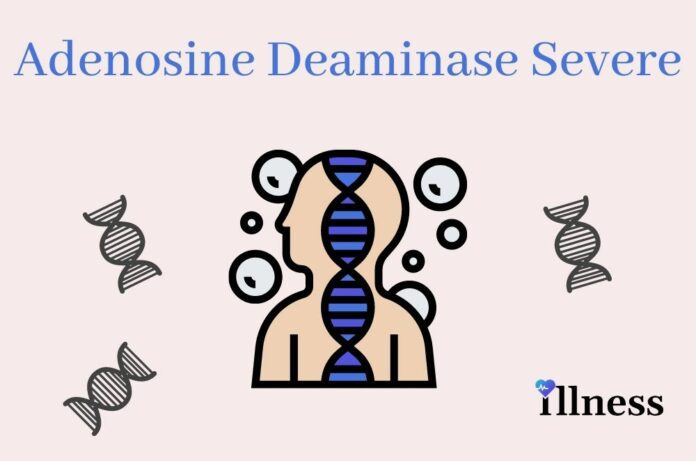Overview Of Adenosine Deaminase Deficiency
Adenosine deaminase deficiency (ADA deficiency for short) is an inherited condition. It attacks and damages the immune system over time until the person eventually develops severe combined immunodeficiency (SCID). Those who have developed SCID have virtually no immune protection whatsoever to fight against invading viruses, bacteria, and fungi. Patients are prone to persistent and repeated opportunistic infections that can often be extremely serious or even life-threatening. The infections are “opportunistic” because they are taking the opportunity to infect immunosuppressed people. These organisms are not normally able to infect people with properly functioning immune systems.
The major symptoms of ADA deficiency that serve as red flags for health care providers are chronic diarrhea, widespread skin rashes, and pneumonia. Children with ADA deficiency may also grow at a much slower rate than unaffected children and can have developmental delays.
Most people with ADA deficiency receive a diagnosis within the first 6 months of life. Usually, it is after they have already developed SCID. Without treatment for their SCID, most babies do not survive beyond 2 years of age. In around 10-15% of cases, SCID doesn’t appear until 6-24 months of age, which is considered a delayed onset. In some very delayed cases, the immune deficiency doesn’t onset until adulthood.
For those with a later onset, their symptoms tend to be less severe. These cases mostly involve ear infections and re-occurring upper respiratory infections. Over time, however, affected patients could develop malnutrition, chronic lung damage, or other health problems.
Commonly Associated With
SCID due to ADA deficiency, ADA-SCID, Adenosine deaminase deficient severe combined immunodeficiency, Severe combined immunodeficiency (autosomal recessive, T cell-negative, B cell-negative, NK cell-negative) due to adenosine deaminase deficiency, and Severe combined immunodeficiency due to ADA deficiency
Causes Of Adenosine Deaminase Deficiency
Changes (mutations) in the ADA gene cause adenosine deaminase deficiency (ADA deficiency). This gene is responsible for making an enzyme that is present in specialized white blood cells (lymphocytes). Lymphocytes are an important part of the immune system and help protect the body from infections. The function of the ADA enzyme is to convert a harmful substance to lymphocytes (called deoxyadenosine) to a non-harmful substance. Mutations in the ADA gene lead to a non-working or poorly working ADA enzyme. This causes deoxyadenosine to build up in the lymphocytes. Because of this build-up, lymphocytes are unable to grow and fight infection, leading to severe combined immunodeficiency.
Symptoms Of Adenosine Deaminase Deficiency
The symptoms of adenosine deaminase deficiency (ADA deficiency) usually become apparent by 6 months of age. Babies with the disorder typically develop chronic diarrhea and serious lung infections. They tend to have trouble gaining the proper amount of weight for their developmental stage. In addition, they do not grow well at all. Other symptoms can include absent tonsils, bone abnormalities, skin rashes, developmental delays, and swollen lymph nodes.
Around 10-15% of those with ADA deficiency do not actually develop symptoms until they are older than six months, usually between the ages of 1-10, or sometimes even into their adult years. In these cases of delayed onset, patients typically receive a diagnosis of combined immunodeficiency (CID) as opposed to severe combined immunodeficiency (SCID) like most patients. The difference in naming is due to the fact that their immune deficiency symptoms are initially milder than the more severe form. Unfortunately, over time those with the milder version of ADA deficiency can develop various health problems, including malnutrition and chronic lung damage.
Treatment Of Adenosine Deaminase Deficiency
The treatments for severe combined immune deficiency (SCID) caused by adenosine deaminase deficiency (ADA deficiency) can include the following:
- Preventative medications to avert specific pneumonia varieties
- Gene therapy
- Stem cell or bone marrow transplants
- Intravenous (IV) immunoglobulin infusions to help support the patient’s natural immune response to infections
- Early diagnosis and prompt treatment of viral, bacterial, and fungal infections
The main treatment for SCID caused by ADA deficiency is stem cell transplantation. These blood-forming stem cells are specifically taken from the bone marrow of an unaffected sibling, so this treatment is only an option in some cases. If possible to perform, this treatment has been found effective in around 70% of patients with SCID. This includes SCID caused by ADA deficiency.
If a bone marrow stem cell transplant (BMT/SCT) isn’t possible for the particular patient, a doctor may recommend enzyme replacement therapy (ERT). In this case, the ERT replaces the missing or defective enzyme adenosine deaminase. The enzyme they use to replace the ADA is a genetically modified form of a bovine enzyme that can be used for humans.
Gene therapy is also another option, although offered only through clinical trials at the moment. Preliminary data shows the treatment to be successful in treating patients with SCID that stems from an ADA deficiency. Gene therapy typically entails replacing the non-working ADA gene copy with a functioning copy so that the patient can produce their own ADA enzyme.
Other
How do medical professionals diagnose an ADA deficiency?
Health care providers can diagnose ADA deficiency one of three ways. The first way, which happens before a child is born, involves taking a very small tissue sample from the amniotic sac (chorionic villus sampling) and testing it for genetic markers of the disorder. The second method, done shortly after a baby is born, involves examining the enzyme levels of a blood sample taken from the umbilical cord. The third method is done at any age, and involves a simple blood sample, taken from the person to check their ADA levels.



